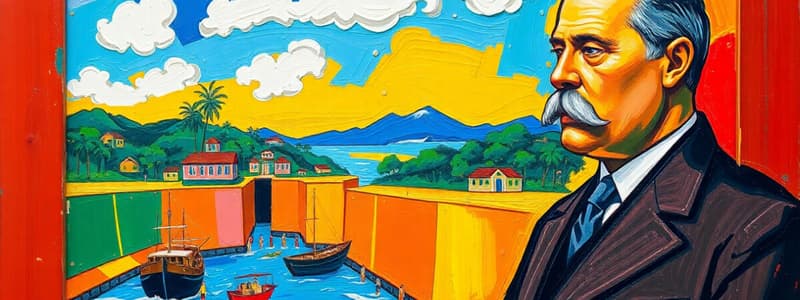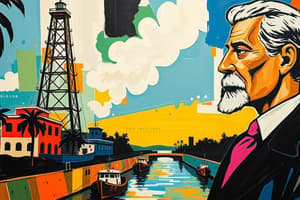Podcast
Questions and Answers
What rationale did Progressive presidents use to justify intervening in the affairs of Western Hemisphere countries?
What rationale did Progressive presidents use to justify intervening in the affairs of Western Hemisphere countries?
- The obligation to protect natural resources from exploitation by foreign powers.
- The desire to establish military bases for national defense.
- The Monroe Doctrine granted the U.S. a special right to oversee the region. (correct)
- The need to spread democratic ideals and institutions globally.
What factor motivated American companies to seek a welcoming economic environment in Caribbean countries during the early 20th century?
What factor motivated American companies to seek a welcoming economic environment in Caribbean countries during the early 20th century?
- To gain stable access to goods like bananas and sugar, and secure bank loans. (correct)
- To establish philanthropic organizations for social welfare.
- To support local governments in implementing land reform policies.
- To promote fair trade practices and economic equality in the region.
What action did Theodore Roosevelt take when Colombia refused to cede land for the Panama Canal project?
What action did Theodore Roosevelt take when Colombia refused to cede land for the Panama Canal project?
- He imposed economic sanctions on Colombia to force compliance.
- He initiated a military invasion of Colombia to seize the land.
- He negotiated a settlement with Colombia involving financial compensation.
- He supported an uprising by Panamanian conspirators to establish independence. (correct)
The construction of the Panama Canal involved workers from which region?
The construction of the Panama Canal involved workers from which region?
Why did the United States intervene in the Dominican Republic in 1904, according to the Roosevelt Corollary?
Why did the United States intervene in the Dominican Republic in 1904, according to the Roosevelt Corollary?
What was the primary focus of William Howard Taft's Dollar Diplomacy?
What was the primary focus of William Howard Taft's Dollar Diplomacy?
What action did Woodrow Wilson take in Haiti when its government refused to allow American banks to oversee its financial dealings?
What action did Woodrow Wilson take in Haiti when its government refused to allow American banks to oversee its financial dealings?
Why did Woodrow Wilson order American troops to land at Vera Cruz, Mexico, in 1914?
Why did Woodrow Wilson order American troops to land at Vera Cruz, Mexico, in 1914?
What was the goal of the expedition led by General John J. Pershing into Mexico in 1916?
What was the goal of the expedition led by General John J. Pershing into Mexico in 1916?
What was the Roosevelt Corollary to the Monroe Doctrine?
What was the Roosevelt Corollary to the Monroe Doctrine?
What long-term consequence resulted from the way the United States initiated the Panama Canal project?
What long-term consequence resulted from the way the United States initiated the Panama Canal project?
How did Woodrow Wilson's foreign policy differ in practice from his stated goals?
How did Woodrow Wilson's foreign policy differ in practice from his stated goals?
What conditions in Mexico led to Wilson's involvement in the country's affairs?
What conditions in Mexico led to Wilson's involvement in the country's affairs?
What motivated marine landings in Caribbean countries between 1901 and 1920?
What motivated marine landings in Caribbean countries between 1901 and 1920?
What event earned Theodore Roosevelt the Nobel Peace Prize?
What event earned Theodore Roosevelt the Nobel Peace Prize?
Which president implemented Moral Imperialism?
Which president implemented Moral Imperialism?
In what country did the US seize control of finances, dissolve the national assembly and rewrite the constitution?
In what country did the US seize control of finances, dissolve the national assembly and rewrite the constitution?
Whose foreign policy was known as Dollar Diplomacy?
Whose foreign policy was known as Dollar Diplomacy?
Who overthrew the government of Porfirio Díaz in Mexico?
Who overthrew the government of Porfirio Díaz in Mexico?
Which of the following people was assassinated?
Which of the following people was assassinated?
Flashcards
Caribbean Interventions
Caribbean Interventions
Between 1898 and 1941, the U.S. intervened militarily in Caribbean countries to protect American economic interests.
"Big Stick" Diplomacy
"Big Stick" Diplomacy
TR's foreign policy: ''Speak softly and carry a big stick''.
Panama Canal Zone
Panama Canal Zone
A zone given to the U.S. to construct and operate a canal. Reduced the sea voyage between East and the West Coasts.
Roosevelt Corollary
Roosevelt Corollary
Signup and view all the flashcards
Dollar Diplomacy
Dollar Diplomacy
Signup and view all the flashcards
Moral Imperialism
Moral Imperialism
Signup and view all the flashcards
Wilson's Latin America Actions
Wilson's Latin America Actions
Signup and view all the flashcards
Vera Cruz Incident
Vera Cruz Incident
Signup and view all the flashcards
Pancho Villa
Pancho Villa
Signup and view all the flashcards
Study Notes
- Progressive presidents expanded American power overseas, initially focusing on the Western Hemisphere.
- The U.S. intervened in Caribbean countries over twenty times between 1901 and 1920, often to create a stable economic environment for American companies.
The United States in the Caribbean, 1898-1941
- Map shows U.S. interventions, military presence, and financial supervision in the Caribbean, including Cuba, Haiti, Dominican Republic, Nicaragua, and Panama
Theodore Roosevelt
- Theodore Roosevelt was more active in international diplomacy and believed in "speaking softly and carrying a big stick".
- Roosevelt facilitated the construction of the Panama Canal.
- Colombia refused to cede land for the canal, Roosevelt supported an uprising by Panamanian conspirators.
- A U.S. gunboat prevented the Colombian army from suppressing the rebellion.
- Panama signed a treaty giving the U.S. the right to construct and operate the canal, and sovereignty over the Panama Canal Zone.
- The Panama Canal construction involved widespread use of immigrant labor, primarily from the Caribbean islands.
- The canal reduced the sea voyage between the East and West Coasts of the U.S. by 8,000 miles and was completed in 1914.
- Roosevelt was credited with taking the Canal Zone.
- In 1977, President Jimmy Carter negotiated treaties to turn over the canal's operation and control to Panama in 2000.
Roosevelt Corollary
- The Roosevelt Corollary was a significant expansion of the Monroe Doctrine.
- It asserted the right of the U.S. to exercise "an international police power" in the Western Hemisphere.
- In 1904, Roosevelt ordered American forces to seize customs houses in the Dominican Republic to ensure debt payment to European and American investors.
- In 1906, he dispatched troops to Cuba to oversee a disputed election, remaining until 1909.
William Howard Taft
- Taft emphasized economic investment and loans from American banks (Dollar Diplomacy).
- Taft landed marines in Nicaragua to protect a government friendly to American economic interests.
Woodrow Wilson
- Woodrow Wilson aimed to respect Latin America's independence, but his "moral imperialism" led to more military interventions than any president before or since.
- In 1915, Wilson sent marines to occupy Haiti, seizing control of finances and rewriting the constitution; American military rule lasted until 1934.
- In 1916, Wilson established a military government in the Dominican Republic, remaining until 1924.
- Wilson's foreign policy revealed a paradox: the presidents who spoke most about freedom were the most interventionist.
Wilson and Mexico
- Wilson's main concern in Latin America was Mexico; the 1911 revolution led by Francisco Madero overthrew dictator Porfirio Díaz.
- Military commander Victoriano Huerta assassinated Madero and seized power; Wilson was appalled.
- Wilson ordered American troops to land at Vera Cruz to prevent weapons from reaching Huerta's forces.
- Mexicans greeted the marines as invaders rather than liberators which surprised Wilson.
- Huerta resigned in 1914 and fled the country; various Mexican factions contended for power.
- Emiliano Zapata led a peasant uprising demanding land reform which was in the southern part of the country.
- The Wilson administration supported Venustiano Carranza, who was dedicated to economic modernization.
- Francisco "Pancho" Villa led a peasant force, raided Columbus, New Mexico, and killed seventeen Americans in 1916.
- Wilson sent 10,000 troops under General John J. Pershing into Mexico to arrest Villa, but it was unsuccessful.
- Violence continued in Mexico, Zapata, Carranza, and Villa were all assassinated.
- Mexico served as a warning that it was difficult to use American might to reorder the internal affairs of other nations.
Studying That Suits You
Use AI to generate personalized quizzes and flashcards to suit your learning preferences.




